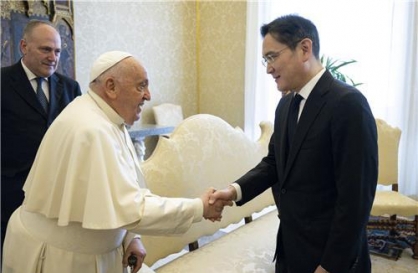Won climbs most among Asian currencies
Local currency expected to reach 1,080 won per dollar by year-end
By Korea HeraldPublished : Oct. 29, 2012 - 20:02
The Korean won has climbed the most against the U.S. dollar among Asian currencies since July as quantitative easing by Europe, the U.S. and Japan added to global liquidity, some of which flowed into Asian emerging markets.
The Korean won has gained 4.3 percent against the greenback since July 2 when European Central Bank president Mario Draghi hinted at a nontraditional monetary policy, marking the steepest appreciation among Asian currencies, according to data from the Bank of Korea.
The domestic currency closed at 1,097 won per dollar as of Friday after breaching the 1,100 won level in the previous session for the first time since Sept. 9, 2011.
The Chinese yuan also gained against the greenback to end at 6.2417 yuan per dollar on Friday, the lowest-ever yuan-dollar exchange rate. The Hong Kong dollar strengthened against the U.S. dollar to 7.7501 Hong Kong dollars per U.S. dollar, the lowest exchange rate in 34 months since Dec. 7, 2009. The Singaporean dollar hit 1.2168 per U.S. dollar on Oct. 18, marking the lowest exchange rate in 13 months since Sept. 9 last year.
Asian currencies began to strengthen in July, and more sharply since the quantitative easing measures in September.
That month, the ECB announced an unlimited government debt-purchasing plan, and the U.S. Federal Reserve vowed to inject $40 billion each month to purchase mortgage-backed securities to revitalize the economy.
Also, more investors chose to buy Asian currencies as their countries promised higher key interest rates than advanced nations, market watchers said.
Korea’s key interest rate currently stands at 2.75 percent, while the U.S. and the eurozone hold comparable rates of 0.25 percent and 0.75 percent, respectively.
The Korean won is likely to remain strong against the greenback for the time being as Seoul is reluctant to intervene in the foreign exchange market and holds abundant foreign reserves, according to market watchers.
“Even if the foreign exchange authorities intervene, they would merely control the speed (of appreciation) and won’t be able to rein in the (appreciation) trend,” said Park Yu-na, a researcher at Dongbu Securities.
“There can be an adjustment, but the local currency is expected to reach the 1,080-won-per-dollar level by the end of this year.”
Korea’s foreign reserves rose to a fresh high in September by reaching $322.01 billion, up $51.3 billion from the previous month, according to the central bank.
Other currencies such as the Malaysian ringgit (4.1 percent), Singaporean dollar (3.6 percent), Swedish krona (3 percent), Thai baht (2.8 percent), Canadian dollar (2.2 percent), Chinese yuan (1.8 percent), Danish krona (1.8 percent), Hong Kong dollar (0.1 percent) and Saudi Arabian riyal (0.01 percent) have also risen against the U.S. dollar since July 2.
By Kim So-hyun (sophie@heraldcorp.com)
The Korean won has gained 4.3 percent against the greenback since July 2 when European Central Bank president Mario Draghi hinted at a nontraditional monetary policy, marking the steepest appreciation among Asian currencies, according to data from the Bank of Korea.
The domestic currency closed at 1,097 won per dollar as of Friday after breaching the 1,100 won level in the previous session for the first time since Sept. 9, 2011.
The Chinese yuan also gained against the greenback to end at 6.2417 yuan per dollar on Friday, the lowest-ever yuan-dollar exchange rate. The Hong Kong dollar strengthened against the U.S. dollar to 7.7501 Hong Kong dollars per U.S. dollar, the lowest exchange rate in 34 months since Dec. 7, 2009. The Singaporean dollar hit 1.2168 per U.S. dollar on Oct. 18, marking the lowest exchange rate in 13 months since Sept. 9 last year.
Asian currencies began to strengthen in July, and more sharply since the quantitative easing measures in September.
That month, the ECB announced an unlimited government debt-purchasing plan, and the U.S. Federal Reserve vowed to inject $40 billion each month to purchase mortgage-backed securities to revitalize the economy.
Also, more investors chose to buy Asian currencies as their countries promised higher key interest rates than advanced nations, market watchers said.
Korea’s key interest rate currently stands at 2.75 percent, while the U.S. and the eurozone hold comparable rates of 0.25 percent and 0.75 percent, respectively.
The Korean won is likely to remain strong against the greenback for the time being as Seoul is reluctant to intervene in the foreign exchange market and holds abundant foreign reserves, according to market watchers.
“Even if the foreign exchange authorities intervene, they would merely control the speed (of appreciation) and won’t be able to rein in the (appreciation) trend,” said Park Yu-na, a researcher at Dongbu Securities.
“There can be an adjustment, but the local currency is expected to reach the 1,080-won-per-dollar level by the end of this year.”
Korea’s foreign reserves rose to a fresh high in September by reaching $322.01 billion, up $51.3 billion from the previous month, according to the central bank.
Other currencies such as the Malaysian ringgit (4.1 percent), Singaporean dollar (3.6 percent), Swedish krona (3 percent), Thai baht (2.8 percent), Canadian dollar (2.2 percent), Chinese yuan (1.8 percent), Danish krona (1.8 percent), Hong Kong dollar (0.1 percent) and Saudi Arabian riyal (0.01 percent) have also risen against the U.S. dollar since July 2.
By Kim So-hyun (sophie@heraldcorp.com)
-
Articles by Korea Herald






![[Weekender] Korean psyche untangled: Musok](http://res.heraldm.com/phpwas/restmb_idxmake.php?idx=644&simg=/content/image/2024/05/02/20240502050841_0.jpg&u=)



![[Herald Interview] ‘Time to Be Strong’ follows retired K-pop idols’ self-discovery](http://res.heraldm.com/phpwas/restmb_idxmake.php?idx=644&simg=/content/image/2024/05/03/20240503050550_0.jpg&u=)







![[Herald Interview] Director of 'Goodbye Earth' aimed to ask how we would face apocalypse](http://res.heraldm.com/phpwas/restmb_idxmake.php?idx=652&simg=/content/image/2024/05/03/20240503050732_0.jpg&u=)
